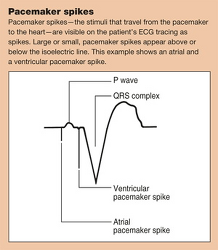
What can go wrong?
Temporary pacing isn't without complications. Insertion of the pacing wire in the subclavian or jugular vein can lead to pneumothorax, hemothorax, or hematoma. Air embolism, infection at the insertion site, and pericarditis are other potential complications.
Temporary pacemaker
Successful capture will show up on an EKG or telemetry as a spike—a perfectly vertical line—followed by a P wave if the atrium is paced; or by an R wave if the ventricle is paced.

Mastering Temporary Invasive Cardiac Pacing

A temporary pacemaker is an “artificial” pacemaker that takes the place of or overrides a faulty SA node. The device is inserted by threading a lead or wire through a vein into the right ventricle of the patient’s heart. At the other end, outside of the patient’s body, the wire is attached to a power source which stimulates the heart to contract.
Temporary pacemakers are often used in emergency situations to keep a person’s heart beat stable until a permanent pacemaker can be inserted. It also may be used after a heart attack to keep the heart rhythm normal until the extent of tissue damage can be established.
http://www.ocaheart.com/patient_services/patient_education/testsandprocedures/Pacemakers/Temporary_Pacemaker.asp
http://www.nhlbi.nih.gov/health/dci/Diseases/pace/pace_whatis.html
http://www.medwrench.com/?equipment.view/equipmentNo/1253/Medtronic/5388-Temporary-Pacemaker/


